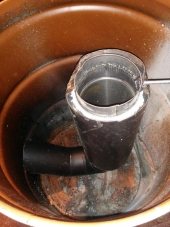Ken Scheffler : Welcome to Permies, and a big welcome to the rocket and the Wood heaters Forums / Threads ! With over 19,000 fellow members scattered around the globe
you can always expect to find someone here nearly 24/7 who wants to talk about what you want to talk about ! The only rule we pay attention to around here is the one you
learned in K'garten play nice !
My wife and I use a 12' yurt as a travel yurt leaving upstate N.Y. in the late fall early winter and traveling where the weather suits our clothes, I have successfully saved my
barrel and the stovepipe that makes up my internal horizontal run through my Thermal Bench Mass, and stored it, I expect to do the same this fall though I am nearly ready to
see how much deterioration will occur over a single winter if I cover my yurt platform inmultiple layers of plastic /tarp and just use the Barrel as the single high point and
leave behind a snow shedding cone !
I flipped a coin and so first you get the lecture on being very careful what you watch on U-Tube , there is a lot of crap out there ! A word to the wise !
I can not stress highly enough that you should go to '
rocket stoves.com' to get your PDF Copy $15.
oo of Ianto Evans great Book 'Rocket Mass Heaters ', there is
STILL No
other book in any language with more Rocket Family information ! (and I don't make a Dime ! )
Here you will learn a common language and the Importance of keeping an internal '' Constant Cross Sectional Area " and the need to keep it Wholey

Much of the mineral fly ash that is left after weeks of burning your Rocket Mass Heater R.M.H., is located within the barrel, you should be looking for a barrel with one open end
with it's top held in place with a clamping band and replaceable gasket ! Barrels are lasting 20 + years ! Just after the barrel in what is called the transitional area ( Where the-
gases change from falling vertically to horizontal, we place our 1st mandatory clean out ! Much of that fine ash is found there !
The Cooling and falling gases create a Differential (heat energy) engine that drives the gasses through the horizontal plane, basically the energy has been paid, and the work is
given up exactly as though the heat engine was powered by the work done as heat energy is discarded at the barrel !
When the planes indians were exposed to canned foods, one of the very first things they did (after emptying the can) was to fit can end to can end sizing up and down as needed
and using the hollow pipe that resulted, (buried in the ground, from outside the Tepee to under the hearthstones)to feed fresh air to the fire !
I want you to go to our sister site, richsoil.com and click on rocket stoves, and then scroll almost all the way to the bottom where you will see a picture of a young lady in a
bathtub in a YURT ! Click on this fine example of Amish Porn, where you will be directed back here to a discussion of in ground heat and be able to see a practical build !
The feed tube should be 1/3rd the total height of the Heat Riser, and the Burn tunnel should be 1/2 the height of the Heat riser (It's o.k., when you get the book it'll make sense)
Being a 30 yr fire fighter it is easy for me to borrow a fire truck to hose the cob off of my pipe if I need to make repairs or refit, I have some doubts that my old, many times
recycled stove pipe would reseal with out painting it with multiple layers of Clay Slip, but my system seems to work fine when so treated and buried in Cob.
Carbon Monoxide will probably show up as a gas that can filter its way through just sand, however, It (carbon monoxide) will only show up in the running of a poorly vented system
and you should have a CO and smoke detector ! I hope this helps and is timely ! For the good of the Craft !
Think like fire, flow like a gas, Don't be the Marsh mallow ! As always, your comments and questions are solicited and are welcome ! PYRO - Logically Big AL











